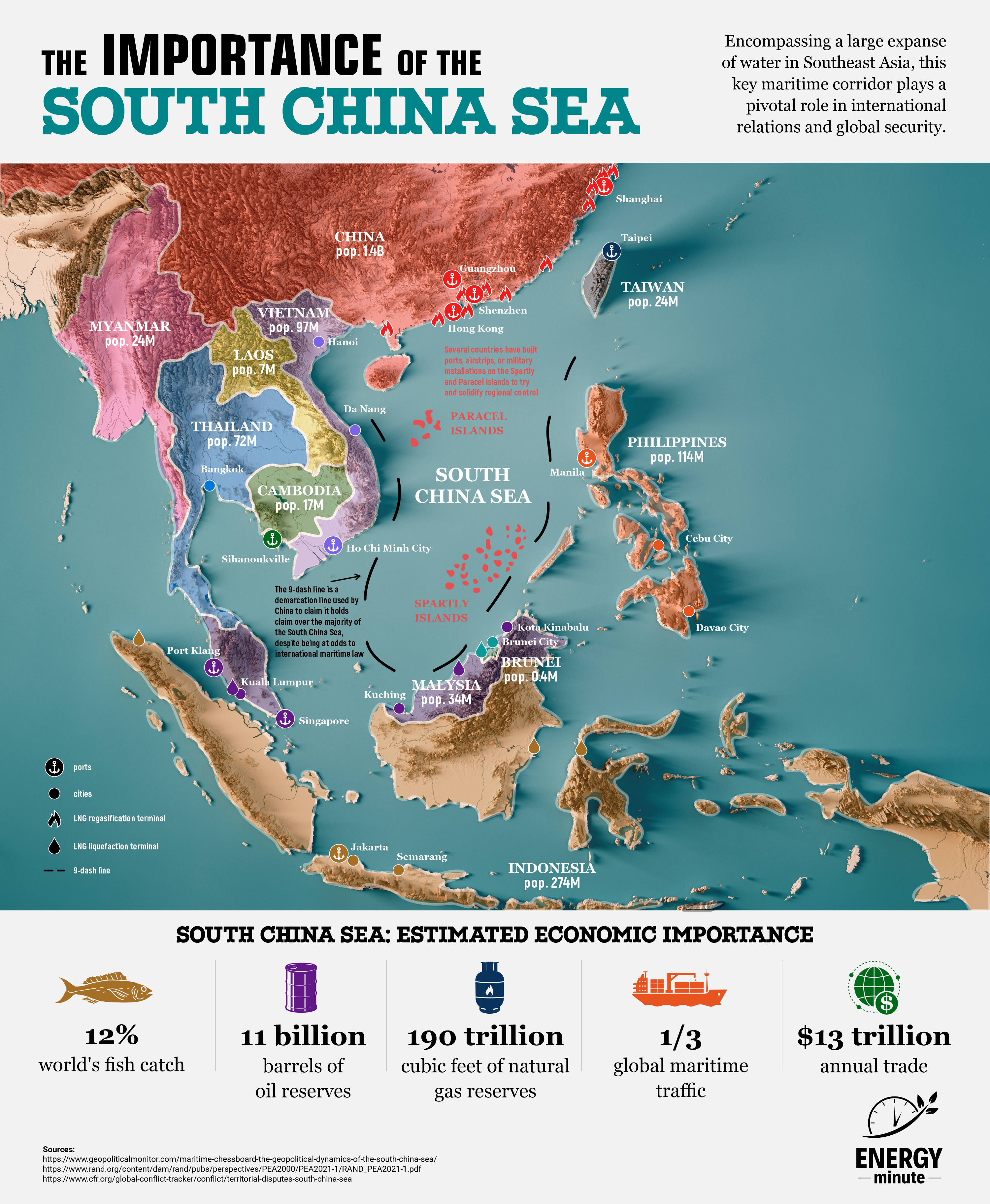Explained: The South China Sea

The South China Sea is an area of significant tension and importance in the realm of international politics and energy security due to its strategic location, rich natural resources, and overlapping territorial claims by multiple countries.
Strategic Location
The South China Sea is a crucial maritime region located in Southeast Asia, connecting the Pacific and Indian Oceans. It serves as a major international trade route, with one-third of the world’s shipping traffic passing through its waters.
Many countries, including China, the United States, Japan, South Korea, and Southeast Asian nations, rely on this sea for the transportation of goods, energy resources, and other essential trade.
Resource Richness: The South China Sea is believed to be rich in natural resources, including 11 billion barrels of crude oil, 190 trillion cubic feet natural gas, and accounts for 12% of the world’s annual fish catch. These resources are essential for the economic development of the countries in the region and have led to competition among nations to secure access to these valuable assets.
Territorial Claims
The South China Sea is the subject of multiple overlapping territorial claims by several nations. China, Taiwan, Vietnam, and the Philippines all assert sovereignty over various parts of the sea. These claims are based on historical arguments, geographic proximity, and international law, particularly the United Nations Convention on the Law of the Sea (UNCLOS).
- China claims territorial sovereignty over much of the South China Sea based on historical records and maps, asserting that the area has been part of its traditional territory for centuries. China points to its “Nine-Dash Line” as a historical boundary that encompasses most of the South China Sea, though this claim has been widely contested by neighboring countries and is not recognized under international law.
- Taiwan, like China, claims territorial sovereignty over parts of the South China Sea, particularly in the Spratly Islands and Paracel Islands. Its basis for these claims is similar to China’s, citing historical records and maps to assert that these areas have been part of its traditional territory, despite these claims being contested by other regional countries and not being widely recognized under international law.
- Vietnam claims territorial sovereignty over parts of the South China Sea, including the Paracel Islands and Spratly Islands, based on historical evidence and geographic proximity. Vietnam argues that it has occupied these areas historically, and its claims align with its maritime boundaries as recognized by UNCLOS, although these claims are also contested by other countries in the region, particularly China.
- The Philippines asserts territorial claims over parts of the South China Sea, specifically in the Spratly Islands and Scarborough Shoal, based on its geographic proximity, historical occupation, and the 200-nautical-mile Exclusive Economic Zone (EEZ) recognized under UNCLOS. These claims have led to tensions with China, which also claims the same areas, resulting in a significant maritime dispute between the two nations.
Freedom of Navigation
Ensuring freedom of navigation and overflight in the South China Sea is a significant concern for the international community. The United States, in particular, conducts freedom of navigation operations (FONOPs) to challenge what it perceives as excessive maritime claims that could impede the rights of other nations to navigate and conduct economic activities in the area.
The United Nations Convention on the Law of the Sea (UNCLOS) is the primary legal framework governing maritime disputes, including those in the South China Sea. While several claimant states are parties to UNCLOS, there is disagreement over its interpretation and enforcement. Some countries, including China, have rejected international arbitration and prefer to negotiate bilaterally.
Geopolitical Implications
The South China Sea has broader geopolitical implications, as it reflects the evolving balance of power in the Asia-Pacific region. China’s growing military presence and assertiveness in the South China Sea have raised concerns among regional neighbors and the United States. The U.S. has sought to strengthen its security alliances and partnerships in the region as a counterbalance.
The stability and security of the South China Sea have a direct impact on the global economy. Disruptions in shipping lanes or resource exploitation could lead to economic instability and higher energy prices, affecting not only the countries in the region but also global trade.
Sources
Maritime Chessboard: The Geopolitical Dynamics of the South China Sea
https://www.rand.org/content/dam/rand/pubs/perspectives/PEA2000/PEA2021-1/RAND_PEA2021-1.pdf
https://www.cfr.org/global-conflict-tracker/conflict/territorial-disputes-south-china-sea
The New Map: Energy, Climate, and the Clash of Nations, Daniel Yergin (2020)
nike air jordan 1 mid outlet | Bulls Hats to Match the Jordan 13 Olive , Travis Scott s Air Jordan 4 Releasing Sooner Than Expected , EverlastsidingShops



